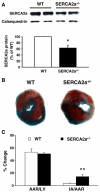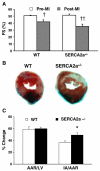Reduced SERCA2a converts sub-lethal myocardial injury to infarction and affects postischemic functional recovery
- PMID: 19046972
- PMCID: PMC2858397
- DOI: 10.1016/j.yjmcc.2008.10.026
Reduced SERCA2a converts sub-lethal myocardial injury to infarction and affects postischemic functional recovery
Abstract
The goal of the present study was to assess how reduced SERCA2a expression affects in vivo myocardial ischemia/reperfusion (I/R) injury. We specifically wanted to determine to what extent hearts with reduced SERCA2a levels are susceptible to in vivo I/R injury. Therefore, we examined the effects of different ischemic periods on post-ischemic myocardial injury in wild-type (WT) and SERCA2a heterozygous knockout (SERCA2a(+/-)) mice expressing lower levels of SERCA2a pump in vivo. Following 20-min ischemia and 48-hour reperfusion, SERCA2a(+/-) mice developed significant myocardial infarction (MI) compared to negligible infarction in WT mice (14+/-3% vs. 3+/-1%, P<0.01); whereas following 30-min ischemia, the infarction was significantly larger in SERCA2a(+/-) mice compared to WT mice (49+/-5% vs. 37+/-3%, P<0.05). Further, echocardiographic analysis revealed worsened postischemic contractile function in SERCA2a(+/-) mice compared to WT mice. Thus, these findings demonstrate that maintaining optimal SERCA2a function is critical for myocardial protection from I/R injury and postischemic functional recovery.
Figures


Similar articles
-
Is reduced SERCA2a expression detrimental or beneficial to postischemic cardiac function and injury? Evidence from heterozygous SERCA2a knockout mice.Am J Physiol Heart Circ Physiol. 2008 Mar;294(3):H1426-34. doi: 10.1152/ajpheart.01016.2007. Epub 2008 Jan 18. Am J Physiol Heart Circ Physiol. 2008. PMID: 18203847
-
Expression of SERCA isoform with faster Ca2+ transport properties improves postischemic cardiac function and Ca2+ handling and decreases myocardial infarction.Am J Physiol Heart Circ Physiol. 2007 Oct;293(4):H2418-28. doi: 10.1152/ajpheart.00663.2007. Epub 2007 Jul 13. Am J Physiol Heart Circ Physiol. 2007. PMID: 17630344
-
Cardioprotective Effects of Serca2a Overexpression Against Ischemiareperfusion- induced Injuries in Rats.Curr Gene Ther. 2017;17(3):248-258. doi: 10.2174/1566523217666171110175251. Curr Gene Ther. 2017. PMID: 29141547
-
Luteolin modulates SERCA2a via Sp1 upregulation to attenuate myocardial ischemia/reperfusion injury in mice.Sci Rep. 2020 Sep 21;10(1):15407. doi: 10.1038/s41598-020-72325-8. Sci Rep. 2020. PMID: 32958799 Free PMC article.
-
AEOL-induced NRF2 activation and DWORF overexpression mitigate myocardial I/R injury.Mol Med. 2025 May 15;31(1):189. doi: 10.1186/s10020-025-01242-1. Mol Med. 2025. PMID: 40375185 Free PMC article.
Cited by
-
Detrimental effects of thyroid hormone analog DITPA in the mouse heart: increased mortality with in vivo acute myocardial ischemia-reperfusion.Am J Physiol Heart Circ Physiol. 2011 Feb;300(2):H702-11. doi: 10.1152/ajpheart.00514.2010. Epub 2010 Dec 3. Am J Physiol Heart Circ Physiol. 2011. PMID: 21131480 Free PMC article.
-
Membrane Repair: Mechanisms and Pathophysiology.Physiol Rev. 2015 Oct;95(4):1205-40. doi: 10.1152/physrev.00037.2014. Physiol Rev. 2015. PMID: 26336031 Free PMC article. Review.
-
Cardiomyocyte-specific overexpression of an active form of Rac predisposes the heart to increased myocardial stunning and ischemia-reperfusion injury.Am J Physiol Heart Circ Physiol. 2013 Jan 15;304(2):H294-302. doi: 10.1152/ajpheart.00367.2012. Epub 2012 Nov 16. Am J Physiol Heart Circ Physiol. 2013. PMID: 23161879 Free PMC article.
-
Targeting calcium transport in ischaemic heart disease.Cardiovasc Res. 2009 Dec 1;84(3):345-52. doi: 10.1093/cvr/cvp264. Epub 2009 Jul 29. Cardiovasc Res. 2009. PMID: 19640931 Free PMC article. Review.
-
Diabetes mellitus exacerbates post-myocardial infarction heart failure by reducing sarcolipin promoter methylation.ESC Heart Fail. 2020 Aug;7(4):1935-1948. doi: 10.1002/ehf2.12789. Epub 2020 Jun 11. ESC Heart Fail. 2020. PMID: 32525286 Free PMC article.
References
-
- Bolli R, Becker L, Gross G, Mentzer R, Jr, Balshaw D, Lathrop DA. Myocardial protection at a crossroads: the need for translation into clinical therapy. Circ Res. 2004;95:125–34. - PubMed
-
- Smith G. Matters of the heart: the physiology of cardiac function and failure. Exp Physiol. 2007;92:973–86. - PubMed
-
- Burns RJ, Gibbons RJ, Yi Q, Roberts RS, Miller TD, Schaer GL, et al. The relationships of left ventricular ejection fraction, end-diastolic volume index and infarct size to six-month mortality after hospital discharge following myocardial infarction treated by thrombolysis. J Am Coll Cardiol. 2002;39:30–6. - PubMed
-
- Talukder MA, Kalyanasundaram A, Zuo L, Velayutham M, Nishijima Y, Periasamy M, et al. Is reduced SERCA2a expression detrimental or beneficial to postischemic cardiac function and injury? Evidence from heterozygous SERCA2a knockout mice. Am J Physiol Heart Circ Physiol. 2008;294:H1426–34. - PubMed
-
- Schultz JEJ, Glascock BJ, Witt SA, Nieman ML, Nattamai KJ, Liu LH, et al. Accelerated onset of heart failure in mice during pressure overload with chronically decreased SERCA2 calcium pump activity. Am J Physiol Heart Circ Physiol. 2004;286:H1146–53. - PubMed
Publication types
MeSH terms
Substances
Grants and funding
LinkOut - more resources
Full Text Sources
Medical

